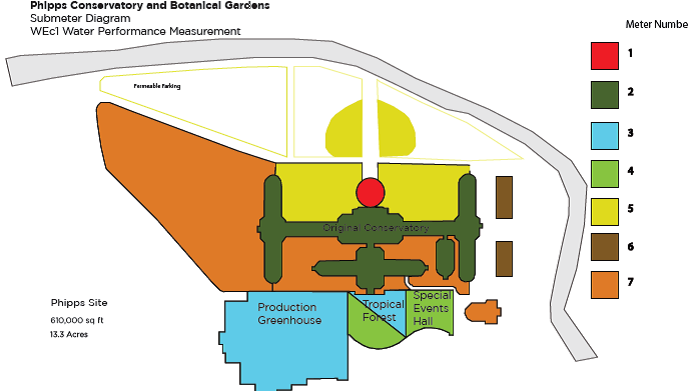Water Efficiency: A Case Study

Water is one of the essential resources that botanical gardens need to support plant life. Gardens need to irrigate plants, but we also need to do it in a sustainable manner. Reducing waste water can better improve groundwater flow, ecosystems, and reservoirs, lower financial costs, and addresses climate change by reducing the need for energy-intensive treatment. For these reasons, the Climate Toolkit has recently added two new goals directly related to water management. If you have achieved or are planning to achieve these goals, please let us know so we can add this information to the database!
Phipps Conservatory used water metering to analyze their consumption of water and leak management to minimize their water loss. In this article, we are going to define water efficiency, Project Drawdown water strategies, EPA water conservation strategies, and water metering within botanical gardens, and explain how the system helped Phipps Conservatory significantly reduce their water waste.
Project Drawdown: Leak Management
Project Drawdown focuses on reducing global carbon emissions by releasing critical information on climate solutions. The nonprofit has released solutions on Transportation, Electricity, Food and Agriculture, Health and Education, Industry and Buildings, among other topics. One of the issues listed within Project Drawdown is Water Distribution Efficiency which “addresses leaks in water distribution networks.” A significant amount of water is lost when pumped to different users within the distribution system. Water utility companies use electricity to pump water throughout their system and is consequentially one of the biggest consumers of electricity. Leaks and cracks can cause a significant amount of water to be pumped back through the pipes to replace what was lost causing more electricity to be used. Project Drawdown recommends either using pressure management or active leak detection to increase water efficiency across campus.
Leaks can be detected using a variety of methods, including water metering, leak detection and pressure management. If an organization installs pressure valves, leaks and cracks can be detected, inspected and sealed. If pressure management and active leak detection is used precisely, Project Drawdown can estimates that water losses “can be reduced by an additional 38 – 47 percent globally by 2050.” Reducing waste water can significant save capital while reducing current carbon emissions.
EPA Efficiency Strategies: Water Metering
The EPA released a guide on the best practices of water efficiency which includes: Water System Management, Leak Management, Metering, Conservation Rate Structure, End Use Water Conservation and Efficiency Analysis, and Water Conservation and Efficiency Plan.
Water Metering can be defined as measuring the flow of water into a system and is designed to track and measure the amount of water used for irrigation and water processing. Water Metering allows users to understand how much water you are using and where you are using it, which will then help you strategize ways in which you can reduce water use.
Phipps Conservatory
Conserving water is essential to addressing the problems related to having combined sewage system in Pittsburgh. When there is significant amount of precipitation, the system overflows sewage and rain into the local rivers. Conserving all water from precipitation and reusing as much sanitary and municipal water is essential to preventing this. Phipps’ water system that is sorted into three sections: sanitary, municipal, and rain water . Phipps utilizes rain barrels, rain gardens and a lagoon to capture water. Water that is stored is used to irrigate their plants, saving potable water in the process. Phipps recycles the sanitary water from the three buildings on its lower campus by circulating the water through a settling tank then constructed wetland and sand filters. The final stage runs the cleaned water past a UV light to kill any pathogens before it is recirculated to flush toilets.
In 2012, water metering was installed throughout the Phipps campus. Phipps’ water metering system is spread out throughout the conservatory, allowing staff to target leaks and cracks. In most cases, research on water metering is focused on potential savings and reduction efficiency within urban systems and residential areas. Phipps Conservatory focused on their current infrastructure to improve their water systems.

With the help of water metering, Phipps found that it used a total 12,050,000 gallons of water throughout the conservatory in 2012. 53% of the total water was used for water features and process water and 44% of the total water was used for irrigation. Phipps realized that there were significant water inefficiencies and waste within their system. Instead of completely rebuilding the system, Phipps focused on upgrading the current infrastructure. This plan consisted of replacing water features with models featuring control boards, timers, and level sensors to reduce overall waste water. In addition to water metering, control boards also allow for leaks and cracks to be easily identified. Water consumption fell at Phipps by 45% and saved about 5.5 million gallons of water. Phipps continuing to improve the systems and technology.
Recommendations
- Phipps recommends using the Living Building Challenge’s Water Petal for guidance on construction and existing retrofits.
- Focus on the reduction of waste water throughout the campus not the financial savings! Return on investment is not applicable for water reductions because this is a slow process completing each small goal at a time.






Recent Comments